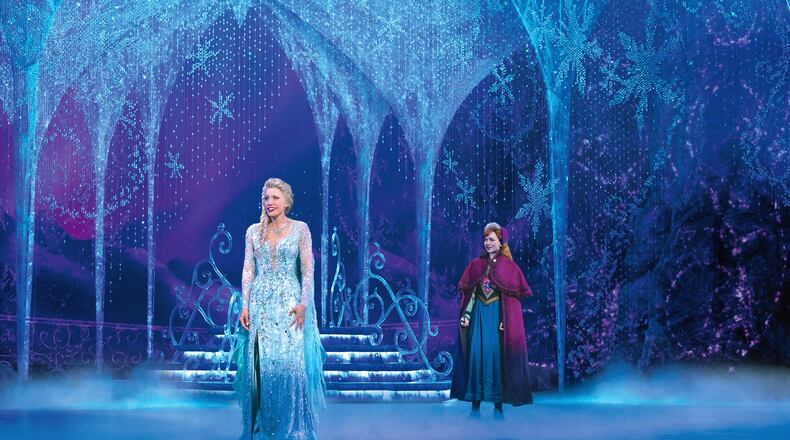For decades, many of Sue McLaughlin’s closest friends have been puppets. At the moment, she’s besties with Olaf and Sven, two of the beloved characters in “Frozen.” The Broadway musical comes to the Schuster Center May 4-14.
McLaughlin travels with the show as “key dresser” and “puppet supervisor.” Before “Frozen” she spent 20 years tending to puppets in “The Lion King.”
Four productions of “Frozen” are making their way around the world, including to Japan, London and Hamburg. The Tony-nominated Best Musical completed its Broadway run in 2020 after breaking house records at New York’s St. James Theatre. Since its Los Angeles premiere in 2019, the North American tour has welcomed more than 1.5 million guests. The production is scheduled to play in 19 cities in 2022-23, including Dayton.
The story
The plot of “Frozen” centers around two sisters, Elsa and Anna. When their parents realize Elsa has magical powers that permit her to create ice and snow and can be harmful, they decide to keep the sisters apart. Elsa struggles to control her unique powers and keep them hidden from those around her. When they are revealed, she leaves the kingdom, inadvertently causing an eternal winter. The rest of the story revolves around the sisters trying to reconnect; Anna is determined to find her sister and save the kingdom. Along the way she encounters a lovable snowman named Olaf, an ice harvester named Kristoff, and his loyal reindeer, Sven.
McLaughlin says one of the major themes of the show is to remind us that romantic love is not the only love that’s important. “Sisterly love and family love are important as well,” she notes.
The musical features a score by Kristen Anderson-Lopez and Robert Lopez, with popular songs such as “Let It Go,” “Do You Want to Build a Snowman?,” and “For the First Time in Forever.” In addition to songs from the original Oscar-winning film, the Broadway version includes new numbers as well.
Don’t be surprised to see 18 trucks in the downtown Dayton streets. “We are a really big show and have 35 in the cast,” says McLaughlin.
Meet Sue McLaughlin
As key dresser, McLaughlin travels with the show and is not only responsible for dressing Sven and Olaf, but maintaining and caring for them as well.
“Sven, the reindeer, is a very important part of the show and an important community member of Arendelle, the place where Elsa and Anna were born,” she explains. “He is a full-body puppet portrayed by one performer. Two actors share the role because it is so physically demanding. Olaf is a magical snowman who comes to life much to everyone’s surprise. He is portrayed by a performer with the puppet suspended in front of him so you can see the performer’s face.”
Much of the Sven puppet’s head, explains McLaughlin, is balanced off the performer’s head and shoulders, an arduous task. With her help, the performer is able to take short breaks backstage during the course of the show. She also helps Olaf get in and out of his puppet. “His hands are occupied operating the mouth of the puppet and the trigger that controls the arms, so he can’t get in and out of the puppet by himself.”
On any given day she might be working on something mechanical inside her puppets or touching up the paint to keep them looking beautiful. Three people in the wardrobe department travel with the show, including one dresser. Other dressers are hired locally in each city.
A costume career
McLaughlin’s fascinating career began when she was still in elementary school. “I grew up in New Hampshire and my mom was a 4-H leader who taught sewing,” she explains. “She taught me to sew. I remember when I was 8 years old. I saw a dress on television I liked, and my mom said: ‘Let’s make one!’”
When she headed for college at Hofstra University in New York, she thought she’d like to be a performer. “I soon realized I had wardrobe skills. I liked working more than auditioning and became a valuable addition to the costume department there.”
After moving to New York and working as a dresser on a show, she found her calling. “I joined the union and ‘dressed’ at Lincoln Center,” she says. " It was exciting to be at Lincoln Center because those were critically acclaimed short runs. They were funded, and as a result, the shows could be more experimental. Working with people at the top of their craft in that environment was so exciting!”
She joined the Broadway company of “The Lion King‘’ in 1998. “It was the first show that so extensively used puppetry and they weren’t sure at the beginning who would take care of the puppets,” she recalls. “Eventually it was decided that if the puppets were on the performer’s body, they would be the responsibility of the wardrobe department but if the puppets were carried the prop department would be in charge. So lots and lots of puppetry fell into the domain of our wardrobe department and I got to work with some of those puppets when I was dressing there.”
When “Lion King” first took to the road, McLaughlin was invited to travel with the puppet department. “That’s where I learned how to care for those beautiful puppets designed by Julie Taymor and Michael Curry, who also did the puppets for ‘Frozen.’”
Today she’s a puppet specialist who most enjoys the problem-solving part of the job. “They are so intricate and require a lot of attention,” she says. “Olaf and Sven are characters that audience members expect to see because they are in the film. Being able to bring them to life is magical to me!”
McLaughlin says audiences can expect to see other magical moments in the show as well. “There is a moment when Elsa finds her power and embraces it and there’s a big transformation for her,” she says. “You’ll see things freeze right in front of you!”
McLaughlin loves telling the stories. “I love the magical elements of theater when we’re able to do something on stage that the audience didn’t expect,” she says. “And I love the responses, especially leaving the theater and seeing little kids.”
Lots of children come dressed as little princesses and occasionally someone shows up in an Olaf or Sven or Kristoff costume. Both children and adults sometimes come as Elsa and Anna.
“This show seems to resonate with lots of people and lots of different ages,” McLaughlin said.
HOW TO GO:
What: “Disney’s Frozen”
When: Thursday, May 4 through Sunday, May 14
Where: Benjamin and Marian Schuster Performing Arts Center, 1 West Second St., Dayton
Tickets: Range in price from $26-$153 and are available at daytonlive.org/frozen and through the Ticket Office from 10 a.m. to 6 p.m. Tuesday-Friday, call (937)228-3630.
Related programming:
- After-School Intensives: Participants will work with local theater professionals, artists, and members of the company when possible) to do music, dance, and scene work from this musical! The sessions are for students ages 8-12 and will be held May 1-5 for students ages 8-12 (daytonlive.org/asi-frozen-1) and May 8-12 for students ages 12-18 (daytonlive.org/asi-frozen-2).
- Background on Broadway: Sixty minutes before each performance you’ll learn about the development, history, and artistry of the show. This free event is held in the Schuster Center’s 4th Floor Lobby. You must have a ticket to that day’s performance.
COSTUME FUN FACTS
- “The fabrics and trims in the costumes are sourced from 17 countries including India, Latvia, Ukraine, Sweden, France and the United States. Elsa’s ice dress takes one person 42 days to bead, with over 10,000 stones.
- There’s no real fur in the show. The fur on Kristoff’s costume is custom knitted. The production uses nearly 30 different kinds of faux fur.
- There are 154 costumes on stage during the course of the show. Swings and understudies have an additional 144 costumes.
- Young Anna has the fastest quick change in the show at only 8 seconds, requiring the assistance of three people.
- There are 48 different kinds of flowers and grasses, and 71 different types of ribbons in the opening garlands.
- There’s a repeated motif of a snowflake in a heart repeated in costumes throughout the show. In addition to being a traditional Scandinavian motif, it reveals some of Anna’s story.
- Every single item of clothing onstage is custom made for the show with the exception of socks, a few pairs of shoes, and the men’s gloves.
- The Ensemble clothes are primarily based on bunad, the folk costumes of Norway. Each region of Norway has its own style and pattern variations of bunad, and the production incorporated many of them into the world of Arendelle.
- Kristoff and Olaf’s costumes are based on the traditional clothing of the Sami, the indigenous people of Scandinavia. Kristoff is firmly rooted in this world, as the Sami culture revolves around reindeer herding.
- The design process began with research and sourcing fabrics, all based around that idea that the costumes needed to function primarily as real clothes.
- Elsa’s clothes are designed to follow her character’s journey. She begins in stiff clothes, fully covered, and always with gloves. This reflects her fear of her own power and the way in which she closes herself off from everyone around her, including her sister. As she becomes more confident in her magic, she sheds these constricting garments and we see her in a dress made of ice that appears to be growing organically from her skin. The curling motifs of ice in this dress reflect her newfound joy. When the story takes a darker turn, Elsa’s ice motifs become sharper and jagged. As she gains independence and moves further from society’s expectations, she even puts on pants.
- The Arendelle crest is a crocus flower. You’ll see this repeated on the set and in the costumes, even in details you may not see from the audience - it’s on Elsa’s shoes, the Guards belts, even on the King’s necklace.
- The show incorporates many elements of hand crafting, which would have been common at the time, including hand beading, knitting, crochet, and needlepoint.
- The production uses the latest developments in theatrical technology, such as digital printing, carbon fiber 3D printing, and thermoplastics.
SOURCE: Publicity for “Frozen.”
About the Author






